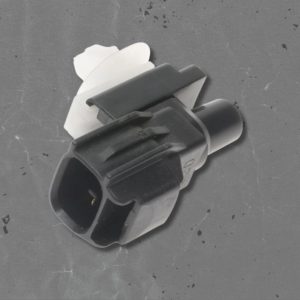A vehicle typically experiences body roll or tilt when it’s going around corners, accelerating, or braking. Some body roll is normal. However, there’s a point where too much tilt or yaw can cause your vehicle to lose traction. Good thing modern vehicles are equipped with yaw rate sensors so that they can execute corrective actions.
What Is the Yaw Rate Sensor?
The yaw rate sensor or yaw sensor typically uses gyroscopes or tuning forks to measure how much and how fast a vehicle is tilting.
A yaw rate sensor measures how much a car rotates around its own axis and is most often installed in the center of the vehicle. The sensor has an internal two-sided tuning fork that is mobilized by a high frequency, which causes the sensor to increase the apparent mass of the fork, and a heavy mass can not quickly change direction. The lower side of the tuning fork is attached to the vehicle so that it turns together with the chassis.

A yaw rate sensor measures how much a car rotates around its own axis and is most often installed in the center of the vehicle.
– Richard McCuistian, ASE Certified Master Automobile Technician
The upper (oscillating) fork on the assembly naturally reacts more slowly because its mass is large so it does not change direction quickly. This naturally causes the central area of the yaw sensor tuning fork to twist. The degree of twisting is measured to provide a value for the yaw rate. This action provides the controller with the number of degrees per unit of time that the vehicle rotates around its axis.
Information from the sensor is used by the vehicle’s onboard computer to improve its overall stability and traction. The computer is especially relevant in hard corners because it can trigger other vehicle systems to intervene to prevent the vehicle from rolling over or losing control. Typically, the vehicle dynamics system will apply just one brake if necessary to re-stabilize the vehicle if, for example, an oversteer situation is detected.
The vehicle typically has a target yaw rate. If the vehicle yaws too quickly, then the onboard computer will determine whether the vehicle is either understeering or oversteering. The computer can trigger corrective actions to stabilize the vehicle and reduce the yaw rate, such as lowering engine power or engaging the vehicle’s torque vectoring system. Torque vectoring is a feature in modern vehicles that allows it to concentrate power on one or more wheels, or engage the brakes in one or more wheels to regain traction.

Bad Yaw Rate Sensor Symptoms
If the yaw rate sensor works properly, it will help keep your vehicle stable. In a worst-case scenario, it can even save you from losing control of your vehicle and getting into an accident. However, just like any other vehicle sensor, it can develop problems from time to time. If you have a bad yaw rate sensor, it might show some of the following symptoms:
Illuminated Check Engine Light
When the yaw rate sensor is functioning properly, information about the yaw rate is sent to the vehicle’s computer. However, if it isn’t detecting signals from the yaw rate sensor, your check engine light will illuminate to inform you of a problem.
A check engine light can activate because of a wide variety of issues, so there might be more underlying issues than just a problem with the yaw rate sensor. You should use a scan tool to check whether there are other issues present in your vehicle.
Illuminated Stability or Traction Control Lights
A vehicle’s stability and traction control system needs information from the yaw rate sensor to function properly. If there’s a problem with the yaw rate sensor, then either one of these lights may activate on your dashboard. The stability and traction control lights typically only illuminate when they are disabled by the driver. If you see either of these lights illuminate, you should go to a mechanic immediately to diagnose the issue. You shouldn’t drive with this problem because it is a key safety issue.

The Stability Control Light Intermittently Flashes
The stability control light can blink on and off when there’s a problem with the yaw rate sensor. However, this can also be caused by other faulty components. When this light flashes, the first thing you should do is stop and restart your vehicle. If the indicator continues to flash, consult a mechanic as soon as possible.
The yaw rate sensor is a critical component of your stability and traction control systems. Without the yaw rate sensor, these systems might not function as they should. Overall, driving without the yaw rate sensor is risky, and you should go to a mechanic as soon as you see any of these symptoms in your vehicle.
Where To Get a New Yaw Rate Sensor for Your Vehicle
We know it isn’t always easy to look for quality replacement parts for your vehicle, especially when some stores can take a long time to ship your order. However, driving without a yaw rate sensor can be dangerous, so it’s best not to get behind the wheel until you replace this sensor with a new one. Thankfully, you don’t have to wait too long if you buy from CarParts.com.
Thanks to our strategically located warehouses, you can expect to receive your part in as fast as two business days. Plus, you can place an order with just a few clicks thanks to our easy-to-use interface.
Order your new yaw rate sensor at CarParts.com now, and you’ll be back behind the wheel before you know it!
Any information provided on this Website is for informational purposes only and is not intended to replace consultation with a professional mechanic. The accuracy and timeliness of the information may change from the time of publication.






























